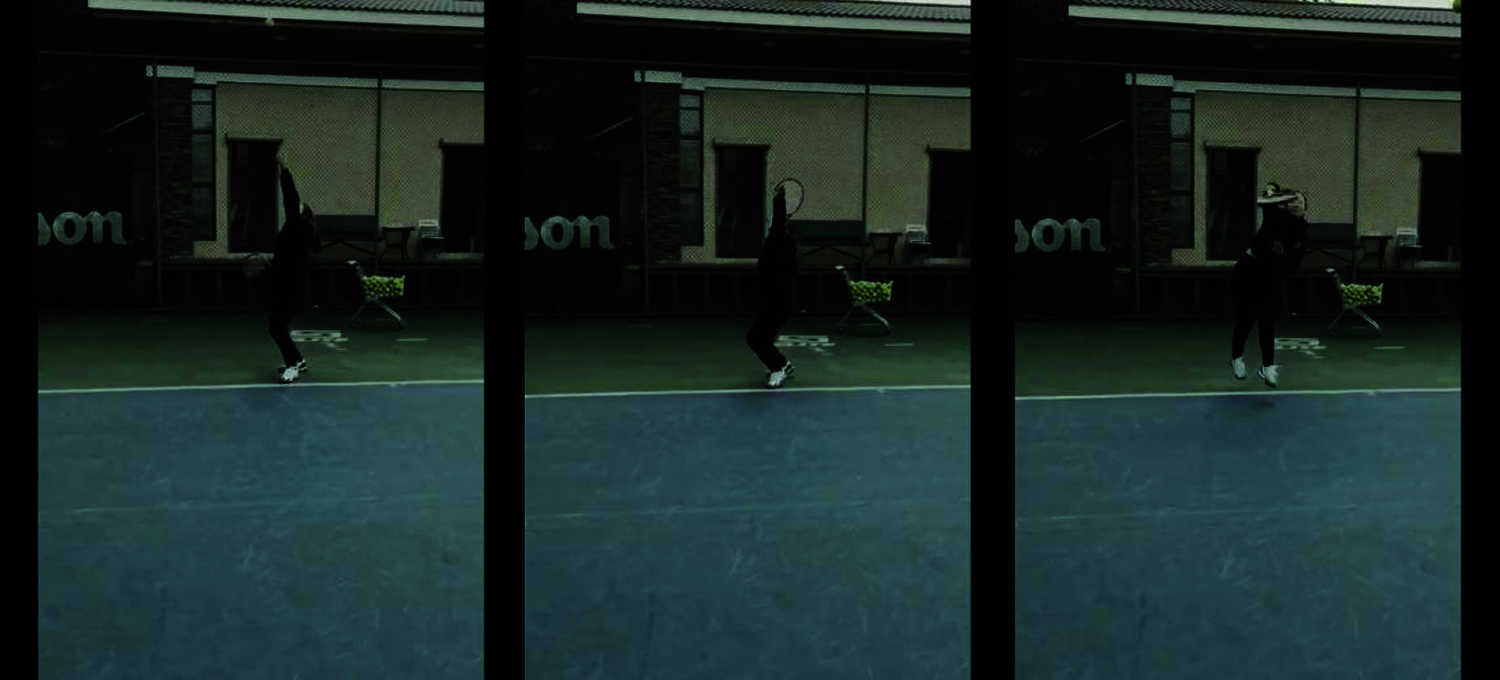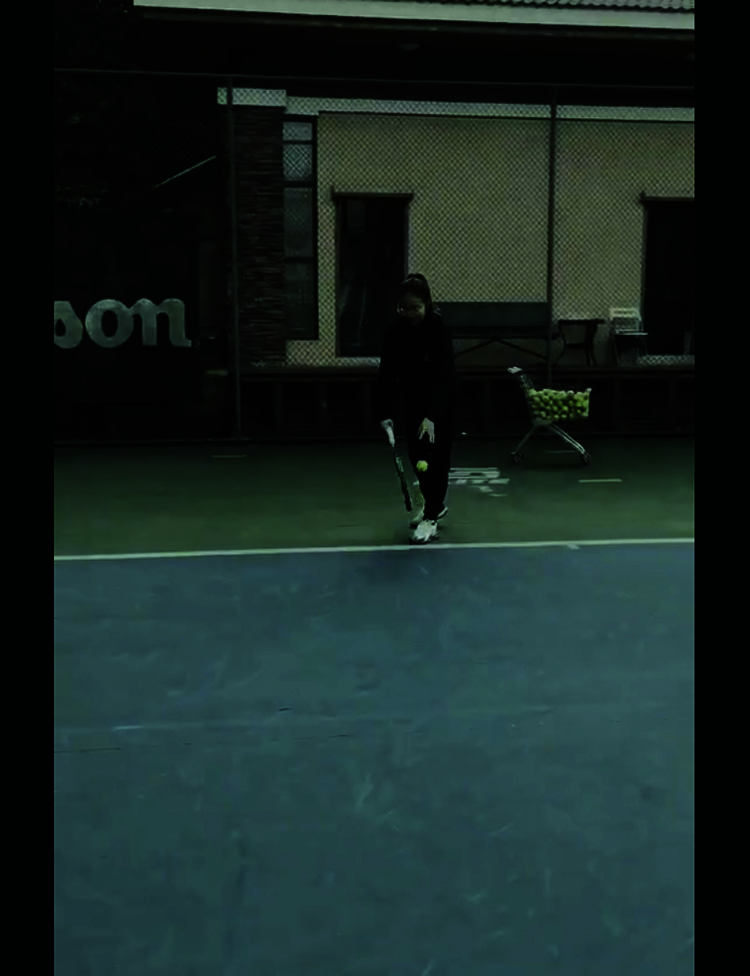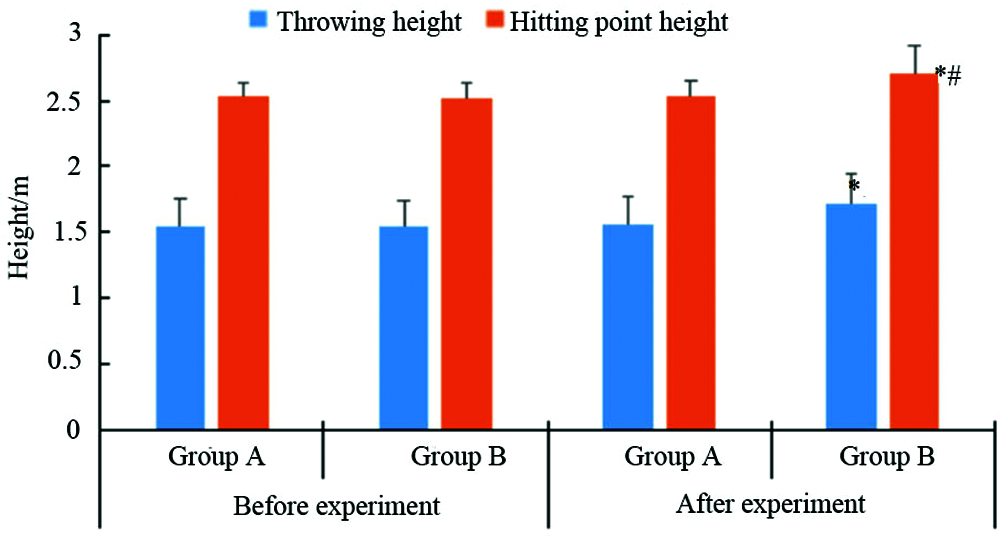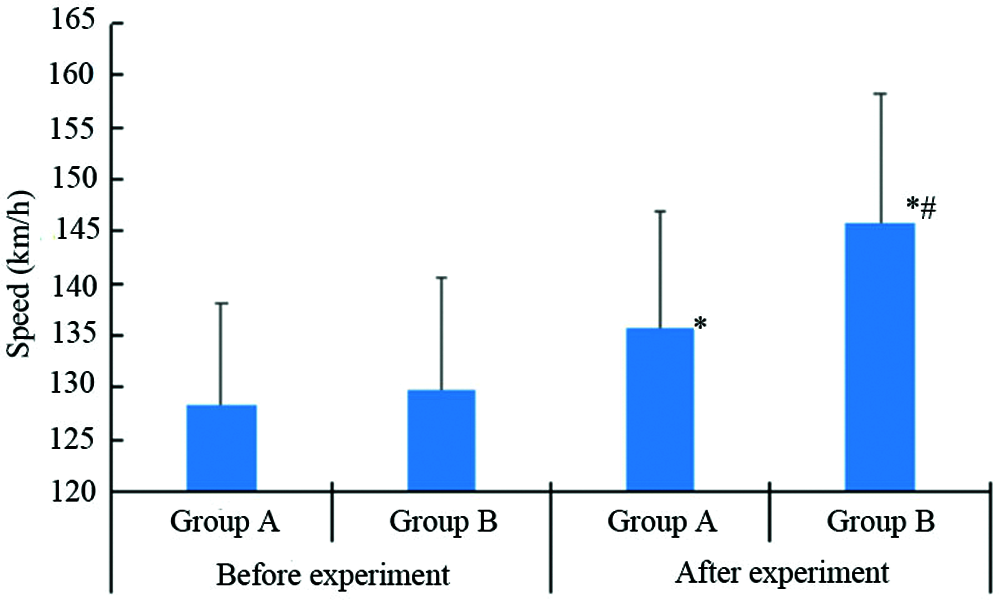

 | Molecular & Cellular Biomechanics |  |
DOI: 10.32604/mcb.2021.017050
ARTICLE
Study on the Effect of Shoulder Training on the Mechanics of Tennis Serve Speed through Video Analysis
1Chengdu Textile College, Chengdu, 611731, China
2Sichuan TOP IT Vocational Institute, Chengdu, 611743, China
*Corresponding Author: Wei Jiang. Email: xunjiangwei13@126.com
Received: 10 May 2021; Accepted: 12 July 2021
Abstract: Tennis service is an important part of winning a match. This study analyzed the mechanics of tennis serving speed and divided ten tennis players into two groups. One group carried out conventional training, while the other group carried out auxiliary training on shoulders through elastic band besides conventional training. The actions were photographed by cameras and analyzed. The results showed that the throwing height and hitting point height of the two groups improved after the experiment, and p < 0.05 in the comparison between Groups A and B; the ball deflection angle reduced after throwing, but the improvement of Group B was more significant compared to Group A (p < 0.05); the service speed and success rate also significantly improved in Group B, i.e., the performance of Group B was better (p < 0.05). The results show that shoulder training plays a positive role in improving the service speed and the video analysis method is reliable in training, which is conducive to improving the training efficiency.
Keywords: Tennis service; video analysis; elastic band; service speed; shoulder
Tennis has a long history of development. It originated in France [1] and was introduced into China at the end of the 19th Century. It has become a world-class event, with great changes in playing methods and skills. Serve is one of the most important actions in tennis [2,3] and also the key and difficult point of teaching [4]. It is the beginning of a confrontation between two parties. In a match, the players usually break the game to suppress the other side through serving. The speed, angle, and landing point of serve is the key to win. Therefore, in a tennis match, it is very important to serve with high quality [5]. In recent years, with the development of computer technology, the information of scenes can be obtained through the pictures taken by the camera. The motion research method based on video analysis can obtain human motion data without affecting the athletes and analyze technical movements, which has been widely used in sports [6]. Klongratog et al. [7] measured the vertical jump height of 30 athletes with remote infrared cameras. Combined with energy conservation and gravity movement, they found that the calculated results of the cameras were slightly different from the measured values in the coordinate system. Caniberk et al. [8] pointed out that monitoring athletes’ movements with cameras and analyze them can reduce movement limitation and unobservable defects. Gksu et al. [9] studied 18 shot putters, recorded their throwing actions by cameras, and then processed data with Skill Spector V1.3.2 and Dartfish Team Pro 5.5. They found that the throwing angle of female athletes was related to the external and internal rotation of the left and right buttocks, the left hip flexion was negatively related to the throwing angle, and the influence of body posture on the throwing was greater than that of male athletes. An et al. [10] designed a dual depth camera motion capture system to analyze athletes’ running. The experiment found that the error of the system for data measurement was 0.0045, i.e., the biomechanical analysis of athletes was feasible. In this study, through video analysis, the mechanical characteristics of tennis service speed were studied. The comparative experiment found that the auxiliary training of the shoulder improved the service speed and the video analysis method could find out the non-standard action in time, which could improve training efficiency and technical level. This work is beneficial to the further application of the video analysis method in sport training and makes some contributions to the further enhancement of coaches’ training and teaching levels.
2 Research Subjects and Methods
Ten tennis players of Chengdu Textile College were taken as the subjects, all of whom were females. They held the racket in their right hand, were healthy, had no physical injury, had good mental conditions, and had no major diseases and bad hobbies. All of them knew the purpose and method of the experiment and signed the informed consent. The players were randomly divided into two groups. One group only received conventional tennis training, named Group A. The other group received auxiliary training on shoulders through elastic band besides the conventional training, named Group B. The general information is shown in Table 1. There was no significant difference between the two groups.

Tennis court is shown in Fig. 1. It is more conducive to scoring if the player can control the falling point of the ball near the two corners of the rectangle to improve the difficulty of the opponent. When serving, the player needs to stand on the left or right side of the midpoint of the baseline and serve to the opponent’s service area. The process is as follows (Fig. 2): the player throws up the tennis ball, leans back, lifts the racket, swings the racket down based on the body’s twist, and hits the ball to make it fall into the opponent’s area quickly. Flat serve is fast and threatening; therefore, this study took flat serve as the research subject.

Figure 1: Tennis court

Figure 2: The serving process
The two groups of players were trained for eight weeks. Group A received conventional tennis training under the guidance of coaches, while Group B used the elastic band to assist shoulder training besides the conventional training. The training content is as follows:
(1) Standing position with external rotation: the player stood naturally, put his hands on the front side of the abdomen, held the elastic band, bent his elbows for 90°, and returned to the starting position after turning to the neutral position.
(2) Standing position with 90° external rotation: the player raised the forearm to parallel to the ground and to form a 90° angle with the trunk, bent elbows for 90°, pulled the elastic band by external rotation, and returned to the starting position after the arms were perpendicular to the ground.
(3) Standing position with 90° internal rotation: the player lifted the forearm to make it perpendicular to the ground, bent the elbow joints for 90°, pulled the elastic band by internal rotation of the forearm, and returned to the starting position after being parallel to the ground.
(4) Service practice: one end of the elastic band was fixed, the height was kept the same level as the highest point of the athlete’s shoulder. The player held the other end tightly with the right hand, stood in a service posture, kept the trunk stable, and pulled the elastic band for service practice.
After tennis training, Group A received the above training every week. Each action was done 12 times, and four actions were taken as one group. The player rested 30 s after every action and rested two minutes after one group. Two groups of actions were done every week.
Before and after the experiment, the serve speed of the two groups was tested. The athletes were photographed by two JVC GR-DVL9800 cameras at a frequency of 100 Hz. The pictures are shown in Figs. 3 and 4. Fig. 3 shows a photo taken by Camera 1 located in front of the athlete, and Fig. 4 shows a photo taken by Camera 2 behind the athlete. The video was analyzed by Ariel video analysis software to calculate the mechanical characteristics of the action. Every player used the same Babolat Pure drive PD GT racket to flatly serve for ten times. Before every test, the players practiced serving once.

Figure 3: A photo taken by Camera 1

Figure 4: A photo taken by Camera 2
The data obtained from video analysis were summarized and sorted in Excel and analyzed in SPSS 18.0 software. Data were expressed as
Before and after the experiment, the comparison of throwing height and hitting point height between the two groups is shown in Fig. 1.
It was seen from Fig. 5 that there was no significant difference in the throwing height and hitting point height between the two groups before the experiment; after the experiment, the throwing height and hitting point height of Group A was 1.56 ± 0.21 m and 2.53 ± 0.12 m (p < 0.05 compared with before the experiment) and the throwing height and hitting point height of Group B was 1.72 ± 0.22 m and 1.72 ± 0.21 m, respectively (p < 0.05 compared with before the experiment and Group A). The above results showed that the throwing height and hitting point height became higher after shoulder auxiliary training, which is more conducive to the smooth completion of the service.

Figure 5: Comparison of throwing height and hitting point height, *: compared to before experiment, p < 0.05, #: compared to Group A, p < 0.05
Before and after the experiment, the comparison of ball deflection angle between the two groups is shown in Table 2.

After the ball was thrown out, whether it was vertical and stable had a great influence on the following serve action. It was seen from Table 2 that there was no significant difference in the ball deflection angle between the two groups after the ball was thrown before the experiment; after the experiment, the left and right deflection angle of the ball in Group A was 5.87 ± 2.12 (p < 0.05 compared to before experiment), and the front and rear deflection angle was 10.68 ± 3.16° (compared with that before the experiment, the deflection angle was slightly decreased, but p > 0.05); the left and right deflection angle of the ball in Group B was 5.33 ± 3.09° (p < 0.05 compared to before experiment and Group A), and the front and rear deflection angle was 9.46 ± 3.34° (p < 0.05 compared to before experiment and Group A). The above results indicated that the conventional tennis training was effective in improving the ball deflection angle, but the effect was not as good as that of Group B that was trained by the shoulder auxiliary training.
Before and after the experiment, the comparison of the serving speed between the two groups is shown in Fig. 6.

Figure 6: Comparison of serve speed, *: compared to before experiment, p < 0.05, #: compared to Group A, p < 0.05
It was seen from Fig. 6 that the service speed of the two groups was 128.43 ± 9.67 km/h and 129.68 ± 10.84 km/h, respectively, before the experiment (p > 0.05). After the experiment, the service speed of group A was 135.69 ± 11.21 km/h (p < 0.05 compared with before the experiment), which indicated that the service speed of Group A significantly improved after conventional training. After the experiment, the service speed of Group B was 145.88 ± 12.36 km/h (p < 0.05 compared with before experiment and Group A), indicating that Group B had a better training effect and significantly improved service speed.
Before and after the experiment, the comparison of the service success rate between the two groups is shown in Fig. 7.

Figure 7: Comparison of service success rate
It was seen from Fig. 7 that the service success rate of the two groups was below 50% before the experiment, and there was no significant difference; after the experiment, the service success rate of Group A was 58.95 ± 7.56%, which showed a significant increase compared with before the experiment (p < 0.05); the success rate of Group B was 73.64 ± 8.12% after the experiment, which showed a significant increase compared with before the experiment, and p < 0.05 compared to Group A, which suggested that Group B had more significant improvement of the service success rate.
In the process of tennis service, the upper limbs, lower limbs, and trunk should participate together [11], and the strength is transferred from bottom to top [12], and finally to the racket [13]. The service speed is maximized through appropriate energy transfer [14]. The shoulder is the link part between the upper limb and the body. The twist of the body drives the shoulder joint and the upper limb to provide energy for the serve. Therefore, shoulders’ stability also has a great influence on the serve speed. In the process of tennis training, there is few special shoulder training; therefore, the role of shoulder training is not clear.
The process of elastic band training is similar to human movement. Elastic bands can train single joint or multiple joints. Its advantage is that athletes can overcome the resistance [15] by motivating more muscles [16] and increasing muscle strength [17] in the centrifugal stage or centripetal stage of limbs. Page et al. [18] found that elastic band training had a short-term effect on the service speed of Spanish squash. Kim et al. [19] found that elastic band training could promote proper muscle development and reduce the common muscle imbalances that dancers often experience when training unfamiliar specific movements or strengthening muscles for specific movements. Thus, shoulder training with elastic bands can promote the coordination of antagonistic and synergistic muscles around the joint, and improve muscle strength, and produce a positive impact on the service speed.
The height of throwing and hitting will not only affect the accuracy of hitting but also affect the rhythm of the whole service. If the throwing is too low, the body cannot be completely extended so that the hitting will be too fast. The height of the hitting point will affect the speed and landing point of the service. If the hitting height is appropriate, enough time difference between throwing and hitting can make the service complete smoothly and ensure service speed. If there is a conspicuous irregular movement track after the ball is thrown, then the athlete needs to determine the position of the ball and adjust the posture, which leads to a slower response to hit the ball and a lower service speed. The results demonstrated no significant difference in the height of throwing and hitting between the two groups before the experiment, but the height of throwing and hitting in Group B significantly improved after the experiment, which was more conducive to the smooth completion of the service. From the perspective of the ball’s deviation after throwing, the player’s posture will affect the trajectory of the ball. If the ball has obvious deviation when being thrown, then before hitting the ball, it is necessary to judge the position of the ball and adjust the posture, which will reduce the accuracy of hitting. Therefore, it is very important to ensure the vertical flying and stability of the ball. It was seen from Table 2 that the ball deviation of the two groups improved, and Group B was more significant, which showed that the effect of throwing the ball in Group B was better and is more conducive to the realization of the ideal service. It was also seen from Figs. 6 and 7 that the service speed of Group B improved more greatly, and the service success rate was also higher. The above results that the shoulder training improved the stability of the shoulder and the support for the service action and thus enhanced the service speed, which resulted in better service.
This paper analyzed the impact of different training methods on tennis serve speed by comparing the results of conventional training and shoulder training and verified the importance of shoulder training to the improvement of the serve speed; moreover, it also verified the reliability of the video analysis method in studying tennis training, which provides some theoretical bases for its further application in actual sport training. However, this article only conducted a relatively sufficient study on serving speed and did not conduct research on serving stability and accuracy, and the research subject was limited to female tennis players. In future research, the scope of the research subject will be expanded, and more tennis indicators will be studied.
This study analyzed the mechanical characteristics of tennis service speed through video analysis and compared the effects of different training methods on service speed from aspects of speed and angle. It was found that:
(1) The throwing height and hitting height of both groups significantly improved; p < 0.05 in the comparison between Groups B and A;
(2) After throwing the ball, the ball deflection angle improved in both groups; p < 0.05 in the comparison between Groups B and A and the comparison in Group B before and after the experiment;
(3) The service speed improved in both groups, but the improvement of Group B was larger;
(4) The service success rate of both groups significantly improved, and p < 0.05 compared to before experiment; the service success rate of Group B was higher than that of Group A (p < 0.05).
The experimental results show that the shoulder training assisted by an elastic band increases the stability of the shoulder, which is more conducive to the smooth completion of the service and improves the quality of service. In the actual training process of athletes, athletes can strengthen shoulder training. This work also verifies the reliability of the video analysis method in sport training, which can be further promoted and applied in practice.
Funding Statement: The authors received no specific funding for this study.
Conflicts of Interest: The authors declare that they have no conflicts of interest to report regarding the present study.
1. Julian, M. (2016). Tennis-court, a part of it called France. Notes and Queries, 1884(219), 219. DOI 10.1093/nq/s6-IX.219.197-g. [Google Scholar] [CrossRef]
2. Meddert, D., O’Shannessy, C., Born, P., Grambow, R., Vogt, T. (2018). Tennis serve performances at break points: Approaching practice patterns for coaching. European Journal of Sport Science, 18, 1–7. DOI 10.1080/17461391.2018.1490821. [Google Scholar] [CrossRef]
3. Kulkarni, A., Ajisafe, T., Mankar, P. (2017). The relationship between lower limb and trunk muscle activation and serving velocity in NCAA male division I tennis players. International Journal of Exercise Science: Conference Proceedings, 2(9), 53–53. [Google Scholar]
4. Ren, C. (2017). Kinematic analysis of tennis flat serve and topspin serve in acceleration phase. Boletin Tecnico/Technical Bulletin, 55(11), 358–364. [Google Scholar]
5. Tubez, F., Forthomme, B., Croisier, J. L., Caroline, C., Bruls, O. et al. (2015). Biomechanical analysis of abdominal injury in tennis serves. a case report. Journal of Sports Science & Medicine, 14(2), 402. [Google Scholar]
6. Lanzotti, A., Costabile, G., Annino, G., Amodeo, G., Odenwald, S. (2016). Video-analysis of player’s kinematics in running out of boundaries in association football fields. Procedia Engineering, 147, 234–239. [Google Scholar]
7. Klongratog, B., Pengto, W., Wornkert, T., Srongprapa, A. (2018). Estimation of vertical jump height using nintendo Wii remote IR camera. The International Conference on Electrical Engineering and Green Energy, vol. 72. Tokyo, Japan. [Google Scholar]
8. Caniberk, M., Sesli, F. A., Cetin, C. (2017). Use of digital photogrammetry in 3D motion analysis and biomechanics of sports. Turkish Journal of Sports Medicine, 51(4), 117–127. DOI 10.5152/tjsm. [Google Scholar] [CrossRef]
9. Gksu, O. C., Kural, D. (2019). Evaluation of the effects of hip joint range of motion and trunk rotation on throwing biomechanics in shot-put throwers: A pilot study. Acta Medica Mediterranea, 35, 2823. DOI 10.19193/0393-6384_2019_5_444. [Google Scholar] [CrossRef]
10. An, W. C., Ngali, M. Z., Kaharuddin, Z., Razak, S. B. K. (2017). Performance of dual depth camera motion capture system for athletes’ biomechanics analysis. 8th International Conference on Mechanical and Manufacturing Engineering 2017, vol. 135. Langkawi, Malaysia. [Google Scholar]
11. Dines, J. S., Bedi, A., Williams, P. N., Dodson, C. C., Ellenbecker, T. et al. (2015). Tennis injuries: Epidemiology, pathophysiology, and treatment. Journal of the American Academy of Orthopaedic Surgeons, 23(3), 181. DOI 10.5435/JAAOS-D-13-00148. [Google Scholar] [CrossRef]
12. Tubez, F., Forthomme, B., Croisier, J. L., Cordonnier, C., Brüls, O. et al. (2015). Biomechanical analysis of abdominal injury in tennis serves. A case report. Journal of Sports Science & Medicine, 14(2), 2. [Google Scholar]
13. Murata, M., Fujii, N., Suzuki, Y. (2015). Mechanical energy flow of the racquet holding arm in the tennis serve, focusing on the energy form. Japan Journal of Physical Education Health & Sport Sciences, 60(1), 177–195. DOI 10.5432/jjpehss.14081. [Google Scholar] [CrossRef]
14. Kenneth, P., Debi, J., Christine, M., Giorgio, Z. (2018). Relationship between range of motion, strength, motor control, power, and the tennis serve in competitive-level tennis players: A pilot study. Sports Health a Multidisciplinary Approach, 10, 194173811878534. DOI 10.1177/1941738118785348. [Google Scholar] [CrossRef]
15. Keivan, G., Hemn, M., Mohammad, G. (2015). Effect of elastic-band exercise on muscle damage and inflammatory responses in taekwondo athletes. Revista Brasileira de Medicina do Esporte, 21(4), 297–301. DOI 10.1590/1517-86922015210495716. [Google Scholar] [CrossRef]
16. Huang, S. W., Ku, J. W., Lin, L. F., Chou, L. C., Liou, T. H. (2017). Body composition influenced by progressive elastic band resistance exercise of sarcopenic obesity elderly women: A pilot randomized controlled trial. European Journal of Physical and Rehabilitation Medicine, 53(4), 556–563. [Google Scholar]
17. Yasuda, T., Fukumura, K., Tomaru, T., Nakajima, T. (2016). Thigh muscle size and vascular function after blood flow-restricted elastic band training in older women. Oncotarget, 7(23), 33595–33607. DOI 10.18632/oncotarget.9564. [Google Scholar] [CrossRef]
18. Page, P., Colado, J. C., Tocino, L., Martin-Rivera, F., Granell, J. C. et al. (2015). Effects of elastic band training on ball velocity in the spanish racquetball serve: 1959 board #304 May 28, 2: 00 PM–3: 30 PM. Medicine & Science in Sports & Exercise, 47(5S), 540. DOI 10.1249/01.mss.0000478175.64651.7f. [Google Scholar] [CrossRef]
19. Kim, M. J., Yi, K. O. (2015). The biomechanical analysis of ballet arabesque by using elastic band. Korean Journal of Sport Biomechanics, 25(3), 265–274. DOI 10.5103/KJSB.2015.25.3.265. [Google Scholar] [CrossRef]
 | This work is licensed under a Creative Commons Attribution 4.0 International License, which permits unrestricted use, distribution, and reproduction in any medium, provided the original work is properly cited. |